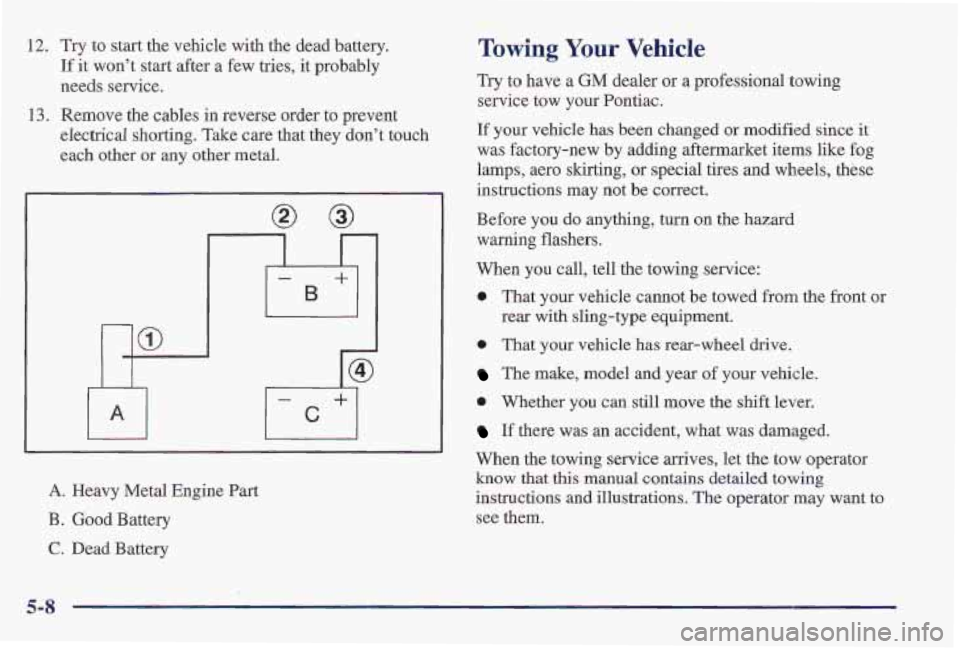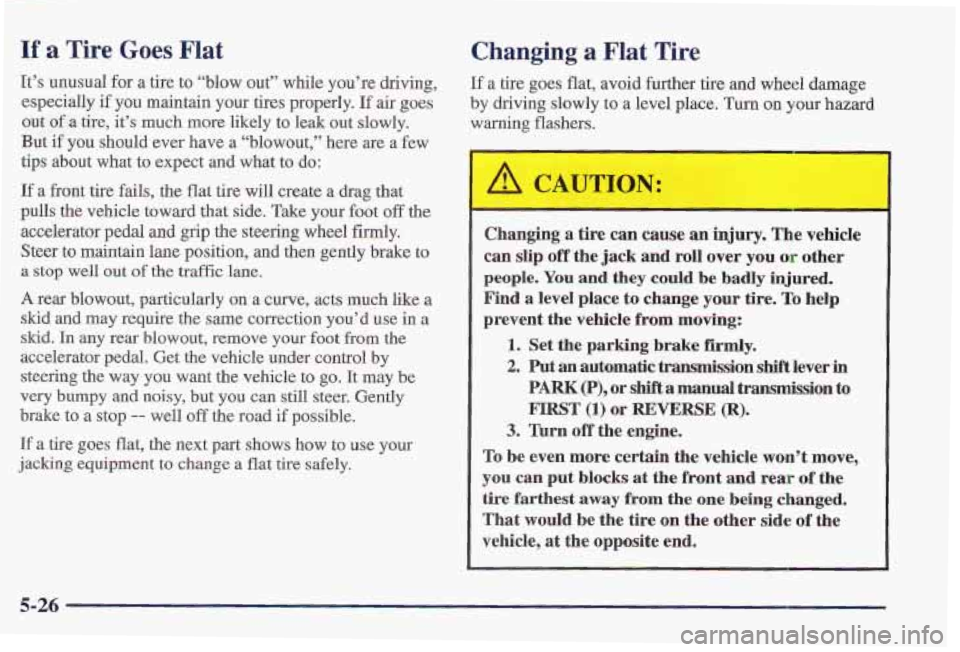warning PONTIAC FIREBIRD 1997 Owner's Manual
[x] Cancel search | Manufacturer: PONTIAC, Model Year: 1997, Model line: FIREBIRD, Model: PONTIAC FIREBIRD 1997Pages: 410, PDF Size: 19.2 MB
Page 206 of 410

Section 5 Problems on the Road
Here you’ll find what to do about some problems that can occur on the road.
5-2
5-3
5-8
5-14
Hazard Warning Flashers
Jump Starting
Towing Your Vehicle
Engine Overheating 5-26 If a Tire Goes Flat
5-26 Changing a Flat Tire
5-38 Compact Spare Tire 5-39
If You’re Stuck: In Sand, Mud,
Ice or Snow
5-1
Page 207 of 410

Hazard Warning Flashers Your hazard warning flashers let you warn others. They
also let police know- you have a problem. Your front and
rear turn signal lamps will flash on and off.
Press the button in to make
your front and rear turn
signal lamps flash on
and off.
Your hazard warning flashers work no matter what
position
your key is in, or even if the key isn’t in.
5-2
Page 208 of 410

To turn off the flashers, pull
out on the collar.
When the hazard warning flashers
are on, your turn
signals won’t work.
Other Warning Devices
If YOU carry reflective triangles, you can set one up at
the side
of the road about 300 feet (100 m) behind
your vehicle.
Jump Starting
If your battery has run down, you may want to use
another vehicle and some jumper cables to start your
Pontiac. But please use the following steps to do
it safely.
JA NTION:
I
Batteries can hurt you. They can be dangerous
because:
They contain acid that can burn you.
They contain gas that can explode or ignite.
They contain enough electricity to burn you.
If you don’t follow these steps exactly, some or all
of these things can hurt you.
NOTICE:
Ignoring these steps could result in costly damage
to your vehicle that wouldn’t be covered by
your warranty.
Trying to start your Pontiac by pushing
or
pulling it could damage your vehicle, even if you
have a manual transmission. And if you have an
automatic transmission,
it won’t start that way.
5-3
Page 213 of 410

12. Try to start the vehicle with the dead battery.
If it won’t start after a few tries, it probably
needs service.
13. Remove the cables in reverse order to prevent
electrical shorting. Take care that they don’t touch
each other
or any other metal.
A. Heavy Metal Engine Part
B. Good Battery
C. Dead Battery
Towing Your Vehicle
Try to have a GM dealer or a professional towing
service tow your Pontiac.
If your vehicle has been changed or modified since it
was factory-new by adding aftermarket items like fog
lamps, aero skirting, or special tires and wheels, these
instructions may not be correct.
Before you
do anything, turn on the hazard
warning flashers.
When
you call, tell the towing service:
0 That your vehicle cannot be towed from the front or
rear with sling-type equipment.
0 That your vehicle has rear-wheel drive.
The make, model and year of your vehicle.
0 Whether you can still move the shift lever.
If there was an ac’cident, what was damaged.
When the towing service arrives, let the tow operator
know that this manual contains detailed towing
instructions and illustrations. The operator
may want to
see them.
5-8
Page 219 of 410

Engine Overheating
You will find a coolant temperature gage on your
Pontiac's instrument panel. You may also find a LOW
COOLANT warning light on your Pontiac instrument
panel
(V8 Engine only).
If Steam Is Coming From Your Engine
Steam from an overheated engine can L,m you
badly, even if you just open the hood. Stay away
from the engine if you see or hear steam coming
from it. Just turn it off and get everyone away
from the vehicle until it cools down. Wait until
there is no sign
of steam or 'coolant before you
open the hood.
If you keep driving when your engine is
overheated, the liquids in it can catch fire. You or
others could be badly burned. Stop your engine if
it overheats, and get out of the vehicle until the
engine is cool.
-
NOTICE:
If your engine catches fire because yon keep
driving
with no coolant, your vehicle can be
badly damaged. The costly repairs
would not be
covered by your warranty.
5-14
Page 220 of 410

If No Steam Is Coming From Your Engine
If you get the overheat warning but see or hear no
steam, the problem may not be too serious. Sometimes
the engine can get a little too hot when you:
Climb a long hill on a hot day.
Stop after high-speed driving.
Idle for long periods in traffic.
Tow a trailer.
If you get the overheat warning with no sign of steam,
try this for a minute or
so:
1. If you have an air conditioner, turn it off.
2. Turn on your heater to full hot at the highest fan
speed and open the window as necessary.
3. If you’re in a traffic jam, shift to NEUTRAL (N);
otherwise, shift to the highest gear while
driving
-- AUTOMATIC OVERDRIVE (@) or
DRIVE (D) for automatic transmissions.
If you no longer have the overheat warning, you can
drive. Just to be safe, drive slower for about
10 minutes.
If the warning doesn’t come back on, you can
drive normally.
If the warning continues, pull over, stop, and park your
vehicle right away.
If there’s still no sign of steam, you can idle the engine
for two or three minutes while you’re parked, to see if
the warning stops. But then, if
you still have the
warning,
turn ofSthe engine and get everyone out of the
vehicle until it cools down.
You may decide not to lift the hood but to get service
help right away.
When you decide it’s safe to lift the hood, here’s what
you’ll see:
Page 222 of 410

Heater and radiator hoses, and other engine
parts, can be very hot. Don’t touch them.
If you
do, you can be burned.
Don’t run the engine if there is a leak.
If you run
the engine,
it could lose all coolant. That could
cause an engine fire, and you could be burned.
Get any leak fixed before you drive the vehicle.
NOTICE:
Engine damage from running your engine
without coolant isn’t covered
by your warranty.
If there seems to be no leak, with the engine on, check to
see if the electric engine fans are running. If the engine
is overheating, both fans should be running. If they
aren’t, your vehicle needs service.
How to Add Coolant to the Coolant
Recovery Tank
If you haven’t found a problem yet, but the coolant level
isn’t at
FULL COLD add a 50/50 mixture of clean water
(preferably distilled) and DEX-COOL@ (silicate-free)
antifreeze at the coolant recovery tank. (See “Engine,
Coolant’’
in the Index for more information.)
Adding only plain water to your cooling system
can be dangerous. Plain water,
or some other
liquid like alcohol, can boil before the proper
coolant mix will. Your vehicle’s coolant warning
system is set for the proper coolant mix. With
plain
water or the wrong mix, your engine could
get too hot but you wouldn’t get the overheat
warning. Your engine could catch fire and you
or
others could be burned. Use a 50/50 mix of clean
water and DEX-COOL@coolant.
5-17
Page 223 of 410

NOTICE:
In cold weather, water can freeze and crack the
engine, radiator, heater core
and other parts.
Use the recommended coolant and the proper
coolant
mix.
You can be burned if you spill coolant on hot
engine parts. Coolant contains ethylene
glycol
and it will burn if the engine parts are hot
enough. Don’t spill coolant on a hot engine. 1
When the coolant in the coolant recovery tank is at
FULL COLD start your vehicle.
If the overheat warning continues, there’s one more
thing you can try. You can add the proper coolant mix
directly to
the radiator but be sure the cooling system is
cool before you do it.
~
1 A CAUTION:
Steam and sc’alding liquids from a hot cooling
system can
blow out and burn you badly. They
are under pressure, and
if you turn the pressure
cap
-- even a little I- they can come out at high
speed. Never turn the cap when the cooling
system, including the pressure cap, is hot. Wait
for the cooling system and pressure cap to
cool if
you ever have to turn the pressure cap.
5-18
Page 231 of 410

If a Tire Goes Flat
It’s unusual for a tire to ‘‘blow out’’ while you’re driving,
especially if you maintain your tires properly. If air goes
out of a tire, it’s much more likely to leak out slowly.
But
if you should ever have a “blowout,” here are a few
tips about what to expect and what to do:
If a front tire fails, the flat tire will create a drag that
pulls the vehicle toward that side. Take your foot off the
accelerator pedal and
grip the steering wheel firmly,
Steer to maintain lane position, and then gently brake to
a st,ot, well out of the traffic lane.
A rear blowout, particularly on a curve, acts much like a
skid and may require the same correction you’d use in a
skid. In any rear blowout, remove your foot from the
accelerator pedal. Get the vehicle under control
by
steering the way you want the vehicle to go, It may be
very bumpy and noisy, but you can still steer. Gently
brake
to a stop -- well off the road if possible,
If
a tire goes flat, the next part shows how to use your
jacking equipment to change a flat tire safely.
Changing a Flat Tire
If a tire goes flat, avoid further tire and wheel damage
by driving slowly t,o a level place.
Turn on your hazard
warning flashers.
Cham- ng a tire can cause an injury. The vehicle
can
slip off the jack and roll over you or other
people. You and they could be badly injured.
Find
a level place to change your tire. To help
prevent the vehicle from moving:
1. Set the parking brake firmly,
2. Put an automatic transmission shift lever in
PARK (P), or shift a manual transmission tu
FIRST (1) or REWRSE (R).
3. Turn off the engine.
To be even more certain the vehicle wan? move,
you can put blocks at the front and rear of the
tire farthest away from the one being changed.
That would
be the tire on the other side of the
vehicle, at the opposite ~ end,
5-26
Page 263 of 410

What to Do with Used Oil
Did you know that used engine oil contains certain
dements that may be unhealthy for your skin and could
even c’ause cancer? Don’t let used oil stay on your
skin
for very long. Clean your skin and nails with soap and
water,
or a good hand cleaner. Wash or properly throw
away clothing or rags containing
used engine oil. (See
the manufacturer’s warnings about the use and dispusal
of oil products.)
Used oil
can be a real threat to the environment, If you
change your
own oil, be sure to drain all free-flowing oil
from the filter before disposal. Don’t ever dispose
of oil
by putting
it in the trash, pouring it on the ground, into
sewers,
or into streams or bodies of? water, Instead,
recycle it by taking it to
a place that collects used oil. If
you have a problem properly disposing of your used oil,
ask your dealer, a service station or a local recycling
center
for help.
Air Cleaner
3800 Engine
6-18